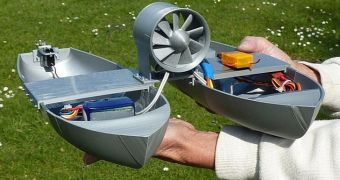Have you ever heard of a Catamaran? That multi-hulled vessel with two parallel hulls of equal size? If you have, you might recognize the design in the remote-controlled motor boat featured in the video down there.
Invented by a designer who goes by the alias of wersy, the boat started out as a normal watercraft that the man would use to spend his free time.
However, the plane out-runner he outfitted the board with proved to be too powerful for the boat in that first incarnation, so he eventually decided to add a second hull.
Each hull was 3D printed separately. Though calling them “hulls” is a bit incorrect, since both are complete boats in their own right (albeit small ones).
The final product looks like two different watercraft held together by the large motor in the center.
Both hulls have hydrofoil design and the specs of a typical sailboat, though the balance between the boat wings and the throttle drive was a bit iffy. Fortunately, this, too, was solved by the dual-hull decision in the end.
As far as 3D printed toys go, it's not likely to end up at Toys”R”Us, not without a paint job, but it's a good solution if you need to give your dog something to bark at during an outing.
You'll note that the weight still shifts a little backwards if you peer attentively enough. Still, the vessel is serviceable, if nothing else.
For those of you who want to know more about how the idea started to take shape and what wersy went through before finally settling on the final form, we've included the video of the first boat draft too.
A 4-cell battery was used to provide the power, and the range of the remote control seems to be as good as that of any radio-directed toy. You'll see that the boat sailed pretty fine in a straight line, but that it took special care when turning to avoid scuttling it. Of course, the dog made sure to “cheer” from the sidelines throughout the entire ordeal.
Eventually, wersy took down part of the hull, the harness closest to the front, and tried again. Unfortunately, once a certain speed was reached, the boat started to tip forward, revealing that the wing had the wrong angle.
That's something that can be remedied in whatever 3D design software he used to make the model though. If things are refined enough, we might see this thing, or the dual-hull version, in stores after all. Unlikely, but not impossible.

 14 DAY TRIAL //
14 DAY TRIAL // 
